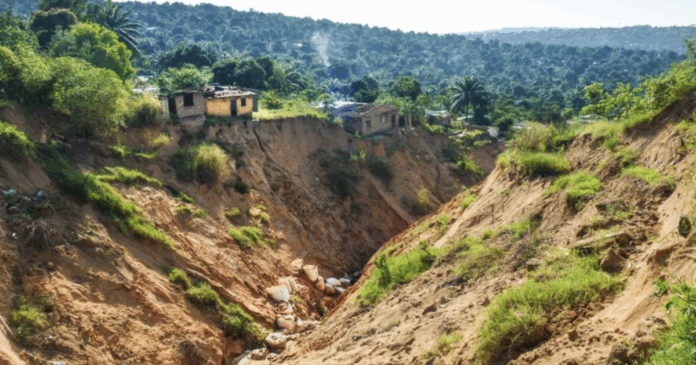Nearly 3,000 growing chasms have opened up in dozens of towns, swallowing up roads and houses in their path. Known as urban gullies, these destructive forces of nature are increasing rapidly and now threaten to displace more than 3.2 million people.
Researchers from Belgium’s Catholic University of Leuven (KU Leuven) with collaborators at the Université Officielle de Bukavu and Université de Kinshasa, have used satellite imaging and comparative data to identify 2,922 giant cracks in the Earth that rip through urban areas that have undergone rapid development. The scientists found that the problem has been grossly underestimated and urgently requires better urban planning and infrastructure to address it.
“Our study is the first to indicate that these gullies are not just isolated incidents,” said study co-author Matthias Vanmaercke, a geographer at the Catholic University of Leuven (KU Leuven) in Belgium. “They are a structural and rapidly growing problem. Even just in Congo, 3.2 million people live in areas at risk. These numbers are similar to the number of people at risk of being affected by landslides or floods. Nevertheless, this is a different kind of danger that is often overlooked.”
When the team cross-checked these new images with historical aerial photographs from the Royal Museum for Central Africa in Belgium, they found that only 46 of the gullies were present in the 1950s.
From Florida to Rome, stories of sinkholes swallowing cars, homes and even whole buildings have made headlines, but this new kind of collapse – vast erosion gullies that carve into cities – is emerging as a far bigger, and more universal, threat than it appears. The researchers found that these urban gullies have so far spread across 26 Congolese cities, stretching more than 435 miles (700 km), with some individual channels measuring tens of meters deep.
“Our results demonstrate the massive magnitude of the problem of UGs (urban gullies),” the researchers noted in the study. “With more than half of the investigated cities affected and more than 2,900 gullies mapped, UGs are a widespread phenomenon.”
The gullies form rapidly as heavy rainwater rushes through poorly drained streets, forming ravines that eat their way through neighborhoods. And unlike sinkholes, which tend to open suddenly and can expand for hours or days, urban gullies continue to grow, expanding in length and width.
“It’s an underestimated and severely under-researched hazard,” said Vanmaercke.
Matthias Vanmaercke
Between 2004 and 2023, the researchers estimate that nearly 120,000 people were displaced as their homes collapsed into these expanding chasms. Since 2020, the pace of displacement has tripled, forcing out an average of 12,000 residents every year. Today, 2.7 million people live within 100 meters (328 ft) of an active gully, while more than three million live in potential expansion zones. Kinshasa, the capital of the Democratic Republic of the Congo (DRC) and one of the fastest-growing cities in the world, currently has 868 separate gullies, many of them cutting straight through densely packed residential neighborhoods.
While heavy rainfall plays a part, urban gullies are largely the result of human activity – roads without drainage, rapidly growing urban sprawl and the removal of vegetation as areas becoming increasingly populated. Now, as climate change brings heavy tropical rainfall, the ground is giving way.
Researchers have called for urgent action, estimating that without intervention, hundreds of thousands of people across Africa are likely to be displaced within the next 10 years, including more than a quarter of the 770,000 or so people living in the expected expansion zones of the DRC gullies. What that intervention looks like is unclear – but starting with more sustainable development and zoning would be a start.
“We need to understand the role of the environment and resources in cities – soil and water particularly – and so engaging experts from those fields is really important,” said Gina Ziervogel, a geographer at the University of Cape Town in South Africa, who added that planning interventions with local residents in the danger zones “would go a long way to understanding their insights, both on the experience of living with this and on potential solutions.”
What’s more, preventing gullies from forming is not just more effective but more economical. The researchers note that stabilizing these chasms after they form can cost upwards of US$1 million – per gully.
“The trick would be to have interventions that are well thought of and installed in time,” said Matthias Vanmaercke, a professor in the Department of Earth and Environmental Sciences at KU Leuven. “But there’s such a huge lack of money and resources that usually when something is done, it’s either inadequate or too late.”
While it may seem like a Global South problem, the same processes play out in vulnerable parts of the West. In Italy, poorly planned hillside roads have triggered collapses, and in US cities like Houston and New Orleans, urban subsidence has resulted due to bad drainage, rapid development and heavy rains. Even Florida’s infamous sinkholes share the same underlying story: human activity that destabilizes ground cover, then heavy rainfall.
The difference, however, is that in wealthier nations, these kinds of disasters often trigger investment in storm drains, soil stabilization or relocation.
“The problem stays under the radar and cities keep expanding to areas that are vulnerable to erosion,” added Vanmaercke. “With our research, we want to highlight the risks connected to this growing problem, and advocate for more preventative measures like better urban planning and infrastructure. We also want to see these erosion gullies included in international disaster risk reduction plans.”
The study was published in the journal Nature.
Source: Catholic University of Leuven


